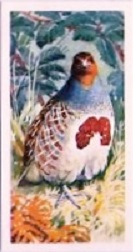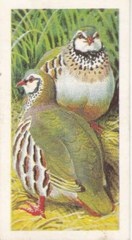The Gamekeeper
I went for a walk and met a retired gamekeeper. The conversation began well, on topics of mutual interest – the condition and habits of rabbits; the increase in numbers of larger birds of prey; and tales of grey – or as he preferred, English – partridges. (To distinguish them from the French or red-legged partridge). There were differences of opinion of course, but I kept them to myself. After a while the conversation turned more to monologue anecdote and, as I had the excuse of a walk to do before lunch, I politely took my leave. However, before I did so, he’d had some interesting tales to tell.


‘English’ partridge French partridge[1]
He confirmed that grey partridges are never run – that is, bred and released for shooting. But he then proceeded to recount in great detail how he had bred greys in the past. He had sought advice from another keeper on how to manage these difficult, wild and pugnacious birds. The secret was to let them choose their own mates, and only then separate them from the others to nest and lay. Other keepers, friends of his, were soon keen to get young birds from his breeding. He was happy to supply them – but would not take any money in exchange. This was a very deliberate policy, in case his boss should hear about it and accuse him of making money on the side and on the boss’s time and resources. After a while, however, the boss did come to hear of it. Another keeper’s boss gave his boss a crate of champagne by way of thanks for the grey partridges supplied. My keeper was then able to say that no money had changed hands – and the boss was moved to say that perhaps he owed his keeper a bottle of champagne from the crate. It was not clear to me whether or not he actually gave him one.
I told him how I had once come upon a gamekeeper’s hut in the woods on the Shedfield Estate – years ago, before it was turned into a golf course. Beside the hut a line of vermin were hung on a pole – crows, weasels, stoats, magpies. As a warning to others, or as evidence of his diligence ? My keeper said this was an old practice, not done these days, but he didn’t explain why not.
He was aware of contemporary opposition to his trade. He had had a number of run-ins with ‘RSPCB’ folk – sometimes face to face, but sometimes surreptitious. One day he released a number of young pheasants into a run. The next morning there were half a dozen buzzards in attendance – put there, he was certain, by the RSPCB people.
We agreed that there had been a notable increase in buzzards in recent decades. And hen harriers, he added, on the grouse moors – showing that he got about a bit. He went regularly with his boss to Scotland as a beater. He also mentioned sparrow hawks and red kites. He disapproved of them all. I suggested the buzzards and kites, as well as magpies, were the result of our providing them with breakfast, lunch and dinner on our roads daily.
The conversation moved from buzzards to rabbits. He was once told by his Head keeper not to disturb a newly arrived buzzard because it would help keep the rabbits down. But nowadays rabbits are scarce, he said. That’s why there are no weasels and stoats anymore. And rabbits are scarce because ‘the ministry people’ have introduced a disease which makes them waste away[2] – and because there’s too many buzzards of course.
I should have stayed and listened to him longer really, but then my walk would have been delayed further and I would have missed my lunch.
*